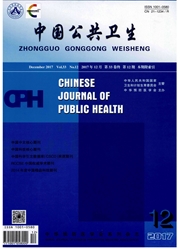

 中文摘要:
中文摘要:
目的探讨超重男性青年膳食产能营养素的摄入特点。方法在黑龙江省哈尔滨市某高校招募82名男性青年志愿者进行连续3 d 24 h回顾性膳食调查,测量其身高、体重、腰围、臀围、腰臀比、体脂比,同时采集空腹静脉血测定其血糖、血脂等生化指标。结果超重组与正常组男性青年摄入总能量比较,差异无统计学意义(P〉0.05);但在能量来源方面,超重组脂肪供能[(29.83±5.81)%]、动物性食品供能[(28.12±8.08)%]和动物性脂肪供能[(44.76±15.80)%]均高于正常组的[(26.18±4.95)%]、[(24.30±7.98)%]和[(35.55±15.89)%],差异均有统计学意义(均P〈0.05);3餐供能方面,超重组晚餐提供能量为(40.19±6.24)%,高于正常组的(36.18±7.18)%,差异有统计学意义(t=2.706,P=0.008);血清生化检测结果显示,超重组血清高密度脂蛋白胆固醇(HDL-C)为(1.21±0.24)mmol/L,低于正常组的(1.36±0.28)mmol/L,低密度脂蛋白胆固醇(LDL-C)、甘油三酯(TG)、总胆固醇(TC)和游率脂肪酸(NETA)分别为(2.62±0.63)mmol/L、(1.37±0.98)mmol/L、(4.72±0.85)mmol/L和(693.33±219.97)μmol/L,均高于正常组的(2.14±0.59)mmol/L、(0.94±0.39)mmol/L、(4.27±0.83)mmol/L和(493.68±189.30)μmol/L,差异均有统计学意义(P〈0.05)。结论超重男性青年应减少脂肪尤其是动物脂肪摄入,可预防肥胖及其他代谢性疾病的发生。
 英文摘要:
英文摘要:
Objective To explore the characteristics of energy nutrients intake in overweight young men. Methods Eighty-two young men aged 19 -28 years were divided into overweight group (n =42) and normal-weight group (n =40) based on their body mass index(BMI) (BMI ≥25.0 kg/cm2 for overweight and BMI ≥ 18.5 kg/cm2 and ≤23.9 kg/cm2 for normal weight). The dietary intake was assessed with 24-hour recall method in a successive 3-day. Anthropometric parameters such as height, weight, waist circumference, hip circumference, body fat, and blood pressure were measured. Fasting blood glucose, triglyceride ( TG ), total cholesterol ( TC ), high-density lipoprotein cholesterol (HDL-C), low-density lipoprotein cholesterol (LDL-C) and, non-esterified fatty acid (NEFA) in serum were also detected. Results Compared with the normal-weight, the overweight had a nonsignificantly higher total energy intake (P 〉0.05) ,but a higher animal food consumption(28.12 ±8. 08% ) and fat intake(29. 83 ±5.81% ) ,especially for ani- mal fat (44. 76 ± 15. 80% higher than that of the normal-weight) (P 〈0. 05). There were significant differences in serum lipids between the two groups(P 〈0.05 for all). Thereinto the overweight had higher LDL-C(2. 62 ±0. 63 mmol/L), TG ( 1.37 ±0. 98 mmol/L) ,TC(4. 72 ±0. 85 mmol/L) ,and NEFA(693.33 ±219. 97 mmol/L) than those of the nor- mal-weight(2. 14 ±0. 59 retool/L,0. 94 ±0. 39 mmol/L,4. 27 ±0. 83 mmol/L, and 493.68 ±189. 30 μmol/L) ,but low- er HDL-C. Conclusion The intake of dietary fat, especially animal fat,in overweight men should be adjusted for the im- provement of obesity to prevent related metabolite diseases.
 同期刊论文项目
同期刊论文项目
 同项目期刊论文
同项目期刊论文
 期刊信息
期刊信息
